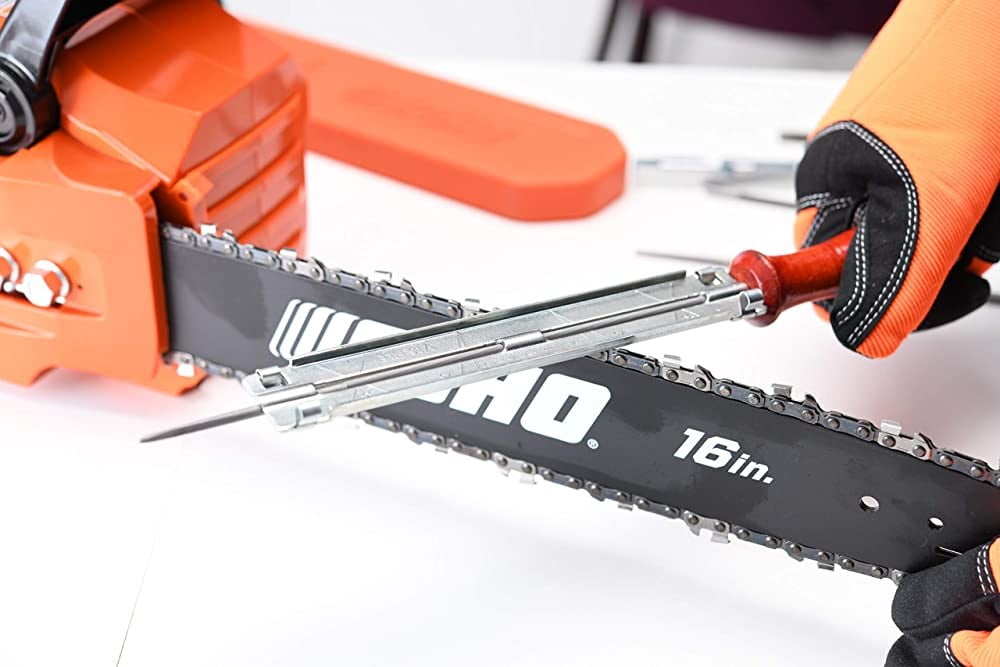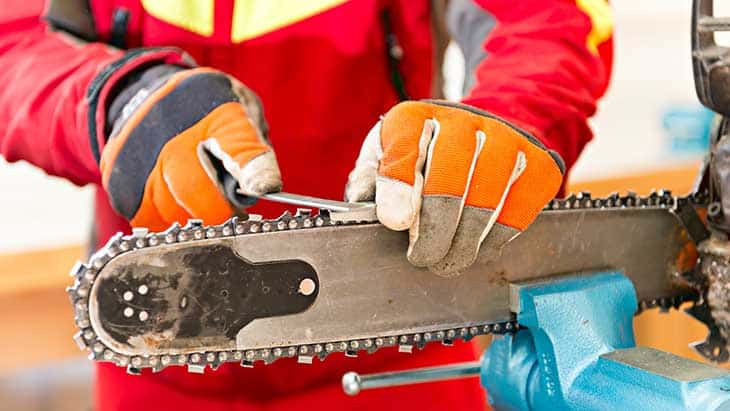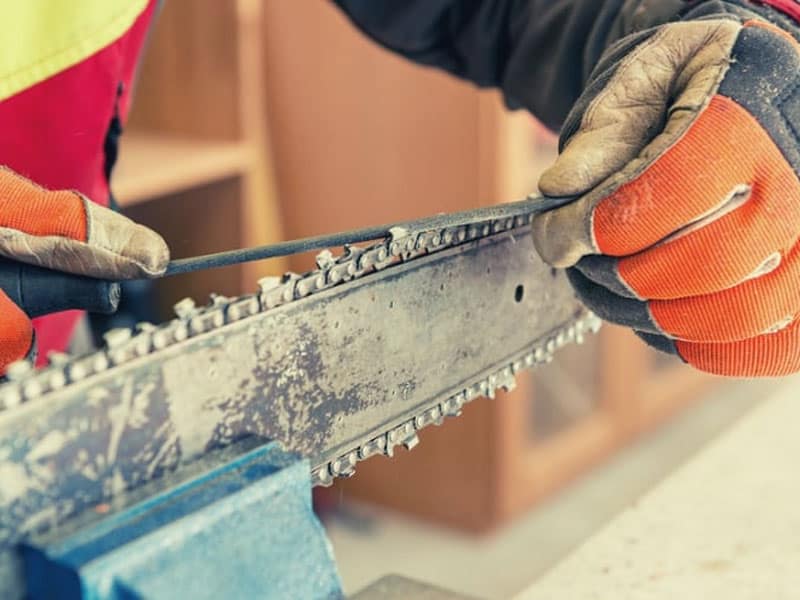Whether you’re a professional lumberjack or a dedicated DIY enthusiast, understanding the importance of using the right file size is crucial for your chainsaw’s optimal performance and longevity.
After reading the article below you will know what size file for chainsaw? So, let’s rev up those engines and dive into the nitty-gritty of sharpening your chainsaw to perfection.
Chain’s Pitch
One crucial aspect of maintaining a chainsaw is the file size for the chain pitch. Chainsaw chains require regular sharpening to ensure optimal cutting performance and longevity. Choosing the correct file size for your chain’s pitch is essential for precise and effective sharpening.
Understanding Chain Pitch: Chain pitch refers to the distance between three consecutive rivets divided by two. It is a fundamental measurement used to determine the compatibility of chains with chainsaw bars and sprockets. The most common chain pitch sizes for chainsaws are 3/8 inch, 0.325 inch, and 0.404 inch.
Selecting the Right File Size: To properly sharpen a chainsaw chain, you must use a file that matches the chain’s pitch. Using the wrong file size can result in an uneven or ineffective sharpening process. Let’s delve into the recommended file sizes for different chain pitch measurements:
- 3/8 Inch Chain Pitch: The standard file size for chains with a 3/8 inch pitch is typically 5/32 inch (4.0 mm). This file size is commonly used for chains with 3/8″ low-profile, 3/8″ full-profile, and 3/8″ low-profile micro chains. It’s important to note that some specialty chains, such as skip-tooth or semi-chisel chains, may require different file sizes. Always refer to the manufacturer’s guidelines for these specific chain types.
- 0.325 Inch Chain Pitch: The recommended file size for chains with a 0.325-inch pitch is typically 3/16 inch (4.8 mm). This file size is commonly used for chains with 0.325″ low-profile and 0.325″ full-profile configurations. Again, certain specialized chains may deviate from this standard, so consult the manufacturer’s recommendations if you have a unique chain variant.
- 0.404 Inch Chain Pitch: The standard file size for chains with a 0.404-inch pitch is typically 7/32 inch (5.5 mm). This file size is generally used for chains with a 0.404″ full-profile configuration. As with the previous chain pitches, it’s important to consider any specialized chains and consult the manufacturer’s guidelines to ensure accurate sharpening.
Understanding File Profiles
File profiles refer to the shape and dimensions of the files used to sharpen chainsaw chains. The two primary file profiles are round and flat files. Each profile has advantages and is suitable for specific chain types and cutting applications.
- Round File Profile: Round file profiles are cylindrical files with a rounded shape. They are commonly used for sharpening chainsaw chains with a standard cutter design. The round file profile is versatile and can effectively sharpen both the cutting edges and depth gauges of the chain.
- Flat File Profile: Flat file profiles are rectangular files with a flat shape. They are primarily used for filing the depth gauges or rakers on chainsaw chains. The depth gauges determine the amount of wood removed by the cutting edges, ensuring safe and efficient cutting performance.

Choosing the Right File Profile: To determine the appropriate file profile for your chainsaw chain, consider the following factors:
Standard Cutter Chains: Standard cutter chains are the most common type and can be sharpened effectively with a round file profile.
Low-Profile Chains: Low-profile chains, such as 3/8″ low-profile or 0.325″ low-profile chains, often require a combination of round and flat file profiles. The cutting edges are sharpened with a round file, while the depth gauges are filed with a flat file.
Chipper Chains: Chipper chains typically have square-shaped cutters and require specialized file profiles.
Chain Manufacturer Recommendations: It’s crucial to consult the chainsaw chain manufacturer’s recommendations regarding file profiles. They provide specific guidelines on file profiles, sizes, and techniques tailored to their chains. Following these guidelines ensures accurate sharpening and prolongs the chain’s lifespan.
Personal Experience and Preference: Experienced chainsaw users may develop their preferences for file profiles based on their cutting needs and sharpening techniques.
Different Types of Chainsaw Files
- Round Files: Round files are the most common and widely used type of chainsaw file. They are cylindrical and ideal for sharpening the cutting teeth on chainsaw chains. Round files are available in various diameters, typically ranging from 3/16 inch to 7/32 inch (4.8 mm to 5.5 mm). The file diameter is selected based on the chain pitch and manufacturer recommendations. Round files are versatile and can effectively sharpen both the cutting edges and depth gauges of the chain.
- Flat Files: Flat files are rectangular-shaped files used primarily for filing the depth gauges or rakers on chainsaw chains. These files have a flat surface and are available in different sizes to match the depth gauge dimensions. Flat files are essential for maintaining the proper height of the depth gauges, which affects the amount of wood removed by the cutting edges. Maintaining the correct depth gauge height ensures safe and efficient cutting performance.
- File Guides: File guides are not files but tools used in conjunction with files to achieve consistent and accurate sharpening results. They provide a guide or template that helps maintain the correct filing angles while sharpening the chain. File guides come in various forms, such as handheld guides or guide frames attached to the chainsaw bar. They are designed to match specific chain pitches and file sizes, ensuring precise sharpening angles and improved cutting performance.

- Depth Gauge Files: Depth gauge files are specialized files used specifically for filing depth gauges on chainsaw chains. These files have a unique shape, typically with a rounded top and a flat bottom. They are designed to maintain the correct height and shape of the depth gauges, preventing excessive wood removal and reducing the risk of kickback during cutting operations. Depth gauge files are available in various sizes, allowing you to match them with your chain’s specific depth gauge dimensions.
- Square Files: Square files are less commonly used in chainsaw maintenance but are sometimes required for certain chains. They are square and are used to sharpen chainsaw chains with square-shaped cutters, such as chipper chains. Square files are not widely used for standard chainsaw maintenance and are usually employed by professional chainsaw operators or individuals working with specialized chain configurations.
Why Does The File Size Is So Important?
Maintaining Cutting Geometry: Chainsaw chains are designed with specific cutting geometry to ensure efficient wood cutting. The cutting teeth on the chain have precise angles, depths, and shapes, enabling smooth and effective cutting performance. The file size directly affects the maintenance of this cutting geometry during the sharpening process.
- Cutting Edge Angles: The file size determines the accuracy of the cutting edge angles achieved during sharpening. Choosing the right file size ensures the correct filing angles are maintained, maximizing cutting efficiency.
- Depth Gauge Maintenance: File size is also crucial when filing the depth gauges or rakers on the chainsaw chain. Depth gauges control the amount of wood the cutting teeth remove, ensuring safe and efficient cutting. Using the appropriate file size ensures accurate and consistent filing of the depth gauges, preventing excessive wood removal and reducing the risk of kickback.
Matching Chain Pitch: Chainsaw chains come in different pitch sizes, which refer to the distance between the chain’s drive links. The file size must match the chain’s pitch for proper sharpening.

- Ensuring Consistent Filing: A file size matching the chain’s pitch ensures consistent filing across the entire chain. It allows the file to fit precisely into the cutter’s gullet, ensuring even sharpening and maintaining uniform cutting performance.
- Compatibility with Filing Guides: File size is important when using filing guides or sharpening kits. Filing guides are designed to accommodate specific chain pitches and file sizes, ensuring proper alignment and sharpening angles. Using the correct file size ensures compatibility with filing guides, enhancing the sharpening process’s accuracy and efficiency.
Optimizing Cutting Performance: Ultimately, the right file size directly impacts the cutting performance of the chainsaw. A properly sharpened chain with the correct file size will cut through wood more effectively, reducing cutting time and minimizing strain on the chainsaw and operator.
What File Size Will A 3/8 Chainsaw Chain Take?
A 3/8 chainsaw chain typically requires a file size of 5/32 inches (4.0 mm). This file size is commonly recommended for sharpening chains with 3/8″ low-profile, 3/8″ full-profile, and 3/8″ low-profile micro chains.
It is important to note that certain specialty chains, such as skip-tooth chains or semi-chisel chains, may have different file size requirements. Always refer to the manufacturer’s guidelines or recommendations provided with the chainsaw chain to ensure accurate sharpening and optimal cutting performance.
What Size File for 0.325 Chain?
The recommended file size for a 0.325 chainsaw chain is typically 3/16 inches (4.8 mm). This file size is commonly used for sharpening 0.325″ low-profile and 0.325″ full-profile chains.
Following the manufacturer’s guidelines or recommendations specific to your chainsaw chain is important, as certain specialty chains may require different file sizes. Adhering to the recommended file size ensures accurate sharpening and helps maintain optimal cutting performance.

